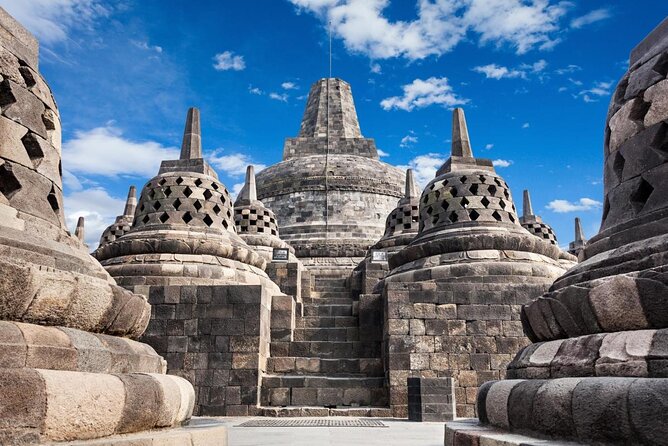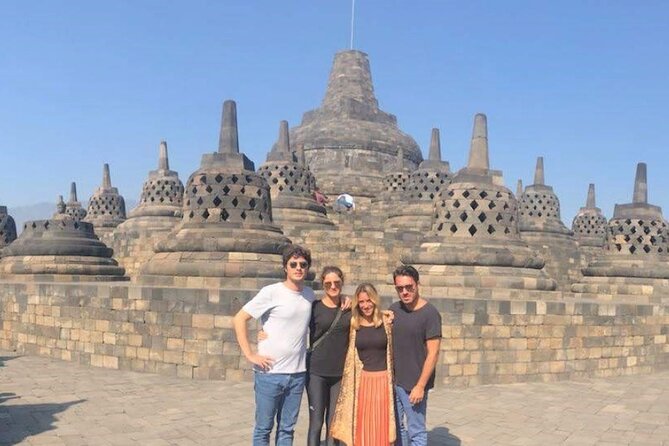In a world where breathtaking sunsets and ancient temples seem to be in endless supply, the Borobudur Temple and the Prambanan Temple stand out as must-visit destinations for those seeking a truly awe-inspiring experience.
Nestled in the heart of Yogyakarta, Indonesia, these two iconic landmarks offer more than just a glimpse into the region’s rich cultural heritage. With their intricate carvings, stunning architecture, and captivating stories, these temples promise to transport visitors to a world of wonder and leave them yearning for more.
So, step into the realm of serenity and architectural mastery as we unravel the beauty and significance of the Borobudur Temple and the Prambanan Temple.
About Our Review: Please note that this is our review of this tour and we do not run, sell, or book tours from this site. If you want to book this tour please click the large button at the base of this page to go to the official listing on Viator.
Good To Know

Image Credit: Viator.com
- Borobudur Temple is the largest Buddhist temple in the world and represents Buddhist cosmology.
- Prambanan Temple is a significant Hindu temple known for its stunning sculptures and religious significance.
- Both temples offer spectacular photo opportunities with intricate details and golden hues.
- Visiting during sunrise or sunset can provide a peaceful and magical experience at both temples.
It's also worth checking out some other tours and experiences nearby.
History of Borobudur Temple

Image Credit: Viator.com
The history of Borobudur Temple is a fascinating tale of ancient craftsmanship and spiritual devotion. This magnificent Buddhist temple, located in Central Java, Indonesia, was built in the 9th century during the reign of the Sailendra dynasty. It took an estimated 75 years to complete and stands as a testament to the ingenuity and skill of the builders.
The temple is adorned with intricate carvings and sculptures, each symbolizing different aspects of Buddhist teachings. The walls of Borobudur are covered in bas-reliefs that depict scenes from Buddhist scriptures, providing a visual representation of the religion’s teachings.
The structure itself is designed to represent the Buddhist concept of the universe. It consists of nine stacked platforms, with the topmost platform adorned with a large central stupa. The entire temple is shaped like a mandala, a symbolic representation of the universe in Buddhist cosmology.
The history and symbolism of Borobudur Temple make it a truly awe-inspiring masterpiece that continues to attract visitors from around the world.
Architecture of Borobudur Temple

Image Credit: Viator.com
With its rich history and intricate carvings, Borobudur Temple stands as a testament to the skill and artistry of its builders, and its architecture is a marvel to behold.
The temple, located in Central Java, Indonesia, was built in the 9th century during the reign of the Sailendra dynasty. It’s a massive structure consisting of nine stacked platforms, adorned with over 2,600 relief panels and 504 Buddha statues.
The architecture of Borobudur Temple reflects the Mahayana Buddhist beliefs and teachings, with each level symbolizing a different stage of enlightenment. The intricate carvings depict scenes from Buddhist scriptures and offer insights into the social and cultural life of the time.
The temple’s unique design and symbolic elements make it a significant cultural and historical landmark.
Significance of Borobudur Temple
One can’t underestimate the profound significance that Borobudur Temple holds in the world of Buddhism and Indonesian history. As the largest Buddhist temple in the world, Borobudur isn’t just a religious site, but also a symbol of cultural heritage and architectural marvel.
Built in the 9th century, the temple represents the Buddhist cosmology and serves as a pilgrimage site for Buddhists from all around the globe. Its intricate architecture showcases the skill and craftsmanship of the ancient Javanese people, with its impressive stone carvings and detailed reliefs depicting Buddhist teachings and stories.
The temple’s significance extends beyond its religious and historical importance, as it also serves as a major tourist attraction in Indonesia, attracting millions of visitors each year. It’s truly a testament to the rich history and cultural diversity of the region.
Plus, the history and architecture of Prambanan Temple, another iconic site in Indonesia, further contribute to the cultural significance of the region.
Sunset Viewing at Prambanan Temple
For an unforgettable experience, learn about the breathtaking sunset views at Prambanan Temple. Here are three reasons why sunset viewing at Prambanan is a must-do:
-
Spectacular Photo Opportunities: As the sun sets over the temple complex, the golden hues create a stunning backdrop for capturing memorable sunset photographs. The intricate details of the ancient Hindu temples are beautifully highlighted, making it a paradise for sunset photography enthusiasts.
-
Cultural Significance: Prambanan Temple holds immense cultural significance in Indonesia. As one of the largest Hindu temples in Southeast Asia, witnessing the sun’s descent over this majestic site is a moment that connects you to the rich history and spirituality of the region.
-
Serene Atmosphere: As the day comes to a close, Prambanan Temple offers a tranquil and serene atmosphere. The fading light casts a peaceful ambiance, allowing visitors to appreciate the architectural brilliance and intricate carvings of the temple complex in a calm and reflective setting.
Don’t miss the chance to witness the mesmerizing sunset at Prambanan Temple, a truly magical experience.
Prambanan Temple Architecture
As the captivating sunset views at Prambanan Temple leave visitors in awe, it’s impossible not to be equally fascinated by the intricate architecture that defines this remarkable Hindu temple complex.
Prambanan Temple is renowned for its stunning sculptures that adorn its walls and towers. These sculptures depict scenes from Hindu mythology, showcasing the skill and craftsmanship of the ancient builders.
The temple complex consists of several interconnected structures, with the main temple dedicated to Lord Shiva. Each structure features intricately carved reliefs and statues, showcasing the rich history and religious significance of the site.
The restoration of Borobudur Temple, another famous temple in the region, serves as a testament to the commitment of preserving Indonesia’s cultural heritage.
Together, these temples stand as magnificent examples of ancient architectural marvels, inviting visitors to explore their beauty and unravel the secrets of the past.
Prambanan Temple’s Hindu Influence
Influenced by Hinduism, Prambanan Temple stands as a majestic testament to the rich religious heritage of Indonesia. This magnificent temple complex, located near Yogyakarta, is a prime example of the Hindu architectural style and symbolism.
Here are three fascinating aspects of Prambanan Temple’s Hindu influence:
-
Intricate Carvings: The temple walls are adorned with intricate carvings depicting scenes from Hindu epics like the Ramayana and the Mahabharata. These carvings serve as a visual narrative of the Hindu mythology and provide insights into the beliefs and values of the ancient Javanese people.
-
Sacred Festivals: Prambanan Temple isn’t only a historical site but also a living place of worship. Throughout the year, various Hindu festivals are celebrated here, attracting devotees and travelers alike. These festivals offer a unique opportunity to witness traditional Hindu rituals and performances.
-
Restoration Efforts: Over the years, Prambanan Temple has undergone extensive restoration to preserve its grandeur. The temple suffered significant damage due to earthquakes and volcanic eruptions, but dedicated restoration efforts have ensured its survival. Today, visitors can marvel at the temple’s intricate details and experience the spiritual aura that still emanates from this iconic Hindu monument.
Tips for Visiting Borobudur and Prambanan Temples
When planning your visit to Borobudur and Prambanan Temples, there are a few helpful tips to ensure a memorable and enjoyable experience. Here are some recommendations to make the most out of your visit:
| Best Photography Spots | Local Food Recommendations |
|---|---|
| Sunrise at Borobudur | Gudeg |
| Prambanan Main Gate | Bakpia |
| Borobudur Temple | Sate Klathak |
| Prambanan Temple | Nasi Gudeg |
| Ratu Boko Temple | Ayam Goreng |
For the best photography spots, make sure to catch the sunrise at Borobudur or capture the majestic Prambanan main gate. Don’t miss the opportunity to take stunning shots of the intricate details of Borobudur and Prambanan Temples.
After exploring the temples, indulge in some local culinary delights. Try Gudeg, a traditional Javanese jackfruit stew, or savor the delicious Bakpia, a sweet pastry filled with mung bean paste. For a more substantial meal, sample the flavorful Sate Klathak or Nasi Gudeg. And if you’re craving fried chicken, Ayam Goreng is a must-try dish.
Best Time to Visit Borobudur and Prambanan Temples
The ideal time to visit Borobudur and Prambanan Temples is during the early morning hours, when the soft golden light of the rising sun bathes these ancient wonders in a breathtaking glow. Here are three reasons why this time is recommended:
-
Capturing the beauty of sunset at Prambanan Temple: While the focus is on the morning hours, it’s important to note that the sunset at Prambanan Temple is equally stunning. The warm hues of the setting sun create a magical ambiance, making it a perfect spot for photography enthusiasts.
-
Avoiding the crowds at Borobudur Temple: Visiting Borobudur Temple early in the morning allows you to beat the crowds and have a more peaceful and intimate experience. As the day progresses, the temple gets busier with travelers, so the early morning hours provide a serene and tranquil atmosphere.
-
Witnessing the sunrise at Borobudur Temple: The sunrise at Borobudur Temple is a truly awe-inspiring sight. As the sun emerges from behind the horizon, it casts a gentle glow on the temple’s intricate carvings and statues. It’s a moment of pure tranquility and spirituality that shouldn’t be missed.
Here's a few more nearby tours and experiences we think you'll like.
- Yogyakarta: Borobudur, Mt. Merapi, Prambanan & Ramayana Tour
- From Yogyakarta: Borobudur Temple Half-Day Guided Tour
- Yogyakarta: Jomblang Cave Tour
- Yogyakarta: Private Car Charter With Driver
- Borobudur Sunrise, Merapi Volcano & Prambanan Full Day Tour
- Yogyakarta: Borobudur & Prambanan All Inclusive Private Tour
Common Questions
How Long Does It Take to Travel From Borobudur Temple to Prambanan Temple?
The travel duration from Borobudur Temple to Prambanan Temple depends on the transportation option chosen. Visitors can expect a scenic journey that takes approximately [insert travel duration] to reach the stunning Prambanan Temple.
Are There Any Restrictions on Photography at Borobudur and Prambanan Temples?
Photography restrictions at Borobudur and Prambanan temples may apply, so it’s important to check the rules before visiting. To capture the best sunset at Prambanan temple, find a good vantage point and adjust your camera settings accordingly.
Is There a Dress Code for Visiting Borobudur and Prambanan Temples?
There is no specific dress code for visiting Borobudur and Prambanan temples. However, it is recommended to dress modestly and respectfully, covering shoulders and knees, as these are sacred sites.
Are There Any Age Restrictions for Visiting Borobudur and Prambanan Temples?
There are no age restrictions for visiting Borobudur and Prambanan temples. Both temples are open to visitors of all ages. Ticket prices may vary depending on the type of tour or package chosen.
Is There a Fee for Entering Borobudur and Prambanan Temples?
There is a fee for entering Borobudur and Prambanan temples. The travel time to both temples can vary depending on the starting point. Visitors will need to pay the entrance fee to access the temples.
Not for you? Here's more of our most recent tour reviews happening neaby
- Yogya Customize Private Tour
- Yogyakarta : Borobudur & Prambanan Tailored Unesco Temple
- Village Cycling Tour in Nanggulan
- Yogyakarta : Discovery Jomblang Cave Tour With Local Guide
- Walking Tour of Yogyakarta’s Oldest Neighbourhood
- Yogyakarta : Jomblang Cave and Pindul Cave Adventure Trip
- Yogyakarta : Prambanan Temple Sunset and Ramayana Ballet
- Yogyakarta : Water Castle, Sultan Palace & Temples
- Yogyakarta : Ramayana Ballet Performance With Dinner
- Yogyakarta Airport : for Pick up or Transfer Service
- Yogyakarta : Prambanan Temple Sunset With Expert Local Guide
- Yogyakarta: 3-Hour Countryside Guided Bike Tour
- Yogyakarta Airport: Private Drop-off or Pick-up to the City
- Yogyakarta : Borobudor and Prambanan Tour
- Yogyakarta Airport: Private Pickup or Drop-off to The City
The Sum Up
To sum it up, a visit to the Borobudur Temple and the Prambanan Temple is an absolute must for anyone interested in experiencing the rich cultural heritage of Yogyakarta.
These ancient architectural marvels offer a glimpse into the past, with their intricate carvings, stunning architecture, and captivating stories.
Whether you’re admiring the levels of enlightenment at Borobudur or witnessing the sunset at Prambanan, these temples will leave you in awe of their beauty and significance.
Don’t miss the opportunity to explore these iconic landmarks and create unforgettable memories.
